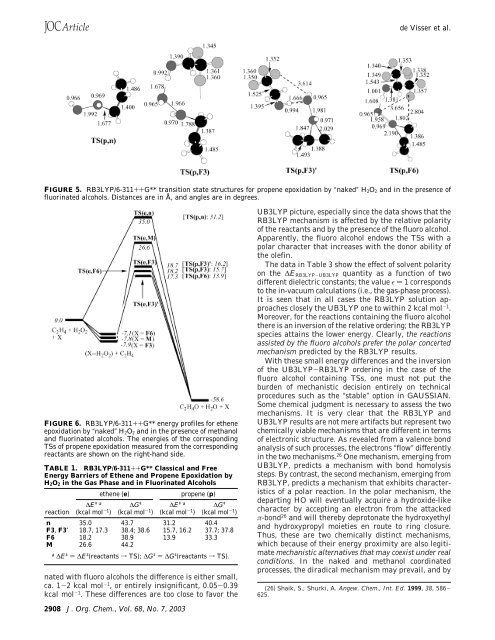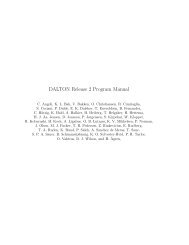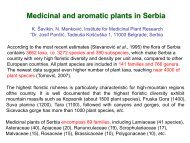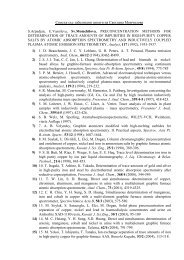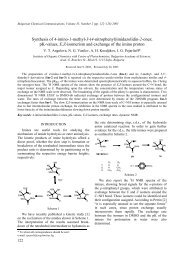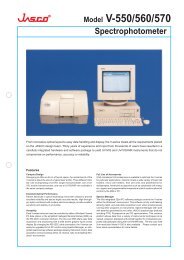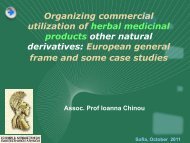Fluorinated Alcohols Enable Olefin Epoxidation by ... - ResearchGate
Fluorinated Alcohols Enable Olefin Epoxidation by ... - ResearchGate
Fluorinated Alcohols Enable Olefin Epoxidation by ... - ResearchGate
Create successful ePaper yourself
Turn your PDF publications into a flip-book with our unique Google optimized e-Paper software.
de Visser et al.<br />
FIGURE 5. RB3LYP/6-311++G** transition state structures for propene epoxidation <strong>by</strong> “naked” H 2O 2 and in the presence of<br />
fluorinated alcohols. Distances are in Å, and angles are in degrees.<br />
FIGURE 6. RB3LYP/6-311++G** energy profiles for ethene<br />
epoxidation <strong>by</strong> “naked” H 2O 2 and in the presence of methanol<br />
and fluorinated alcohols. The energies of the corresponding<br />
TSs of propene epoxidation measured from the corresponding<br />
reactants are shown on the right-hand side.<br />
TABLE 1. RB3LYP/6-311++G** Classical and Free<br />
Energy Barriers of Ethene and Propene <strong>Epoxidation</strong> <strong>by</strong><br />
H 2O 2 in the Gas Phase and in <strong>Fluorinated</strong> <strong>Alcohols</strong><br />
ethene (e)<br />
propene (p)<br />
reaction<br />
∆E q a<br />
(kcal mol -1 )<br />
∆G q<br />
(kcal mol -1 )<br />
∆E q a<br />
(kcal mol -1 )<br />
∆G q<br />
(kcal mol -1 )<br />
n 35.0 43.7 31.2 40.4<br />
F3, F3′ 18.7, 17.3 38.4; 38.6 15.7, 16.2 37.7; 37.8<br />
F6 18.2 38.9 13.9 33.3<br />
M 26.6 44.2<br />
a ∆E q ) ∆E q (reactants f TS); ∆G q ) ∆G q (reactants f TS).<br />
nated with fluoro alcohols the difference is either small,<br />
ca. 1-2 kcal mol -1 , or entirely insignificant, 0.05-0.39<br />
kcal mol -1 . These differences are too close to favor the<br />
UB3LYP picture, especially since the data shows that the<br />
RB3LYP mechanism is affected <strong>by</strong> the relative polarity<br />
of the reactants and <strong>by</strong> the presence of the fluoro alcohol.<br />
Apparently, the fluoro alcohol endows the TSs with a<br />
polar character that increases with the donor ability of<br />
the olefin.<br />
The data in Table 3 show the effect of solvent polarity<br />
on the ∆E RB3LYP-UB3LYP quantity as a function of two<br />
different dielectric constants; the value ɛ ) 1 corresponds<br />
to the in-vacuum calculations (i.e., the gas-phase process).<br />
It is seen that in all cases the RB3LYP solution approaches<br />
closely the UB3LYP one to within 2 kcal mol -1 .<br />
Moreover, for the reactions containing the fluoro alcohol<br />
there is an inversion of the relative ordering; the RB3LYP<br />
species attains the lower energy. Clearly, the reactions<br />
assisted <strong>by</strong> the fluoro alcohols prefer the polar concerted<br />
mechanism predicted <strong>by</strong> the RB3LYP results.<br />
With these small energy differences and the inversion<br />
of the UB3LYP-RB3LYP ordering in the case of the<br />
fluoro alcohol containing TSs, one must not put the<br />
burden of mechanistic decision entirely on technical<br />
procedures such as the “stable” option in GAUSSIAN.<br />
Some chemical judgment is necessary to assess the two<br />
mechanisms. It is very clear that the RB3LYP and<br />
UB3LYP results are not mere artifacts but represent two<br />
chemically viable mechanisms that are different in terms<br />
of electronic structure. As revealed from a valence bond<br />
analysis of such processes, the electrons “flow” differently<br />
in the two mechanisms. 26 One mechanism, emerging from<br />
UB3LYP, predicts a mechanism with bond homolysis<br />
steps. By contrast, the second mechanism, emerging from<br />
RB3LYP, predicts a mechanism that exhibits characteristics<br />
of a polar reaction. In the polar mechanism, the<br />
departing HO will eventually acquire a hydroxide-like<br />
character <strong>by</strong> accepting an electron from the attacked<br />
π-bond 26 and will there<strong>by</strong> deprotonate the hydroxyethyl<br />
and hydroxypropyl moieties en route to ring closure.<br />
Thus, these are two chemically distinct mechanisms,<br />
which because of their energy proximity are also legitimate<br />
mechanistic alternatives that may coexist under real<br />
conditions. In the naked and methanol coordinated<br />
processes, the diradical mechanism may prevail, and <strong>by</strong><br />
(26) Shaik, S.; Shurki, A. Angew. Chem., Int. Ed. 1999, 38, 586-<br />
625.<br />
2908 J. Org. Chem., Vol. 68, No. 7, 2003


